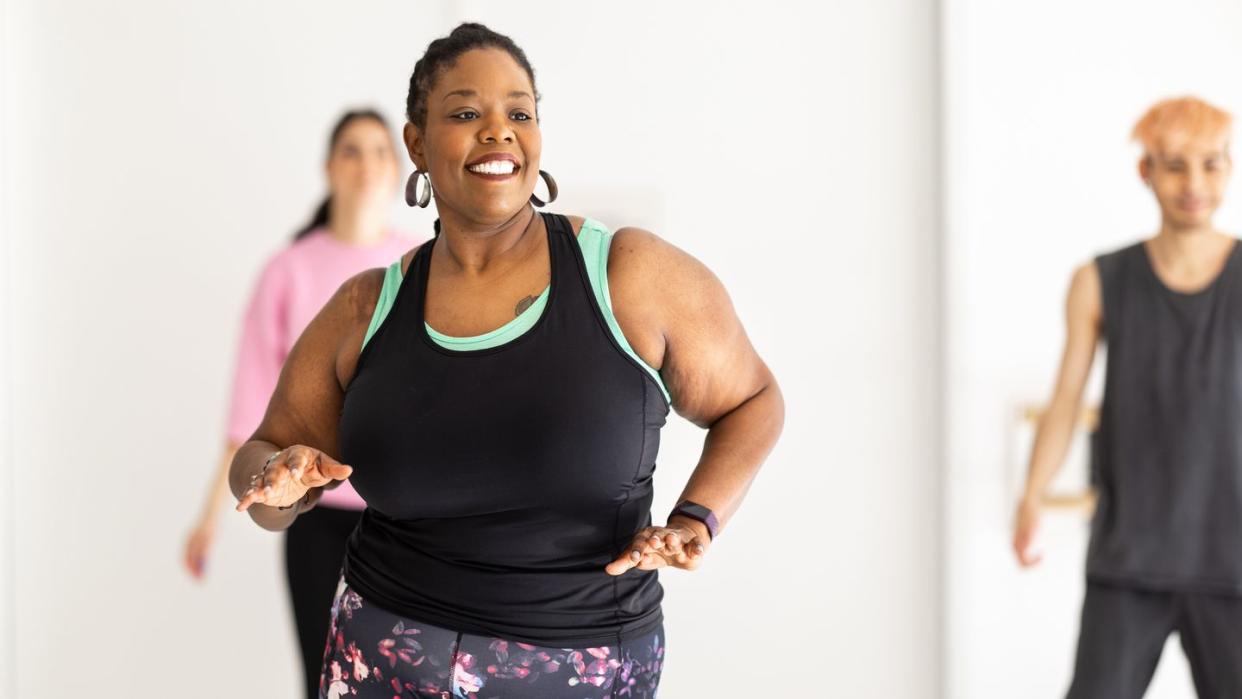These Are the Best Cardio Exercises for Weight Loss

"Hearst Magazines and Yahoo may earn commission or revenue on some items through these links."
[table-of-contents] stripped
If you’re new to exploring exercises for losing weight, it can be tricky to know where to start. There’s weight training, yoga, pilates, barre, and more. But many people—personal trainers included—are believers in the simple power of cardio for weight loss. (However, research shows a well-rounded fitness routine for weight loss includes both cardio and strength training.)
Meet the Experts: Tim Landicho, C.S.C.S., N.S.C.A.-certified strength and conditioning specialist and Tonal fitness coach and Denise Chakoian, C.P.T., owner and founder of CORE Cycle.Fitness.Lagree.
At its core, cardio is movement that elevates your heart rate and keeps it there for a the duration of a workout, explains Tim Landicho, C.S.C.S., N.S.C.A.-certified strength and conditioning specialist and Tonal fitness coach. “The goal here is to engage large muscle groups in rhythmic, repetitive movements, which, in turn, increases your heart rate and breathing,” he adds.
The basic formula to losing weight is to burn more calories than you consume (though it’s not always that easy), Landicho says, and cardio leads that effort by burning calories long after your sweat sesh ends through a process called excess post-exercise oxygen consumption (EPOC), he adds. According to the National Association of Sports Medicine, EPOC is characterized by an increased oxygen intake and metabolism that takes place while the body recovers from exercise.
“Cardio is good for weight loss as it decreases the body’s ability to hold onto calories and fat,” adds Denise Chakoian, C.P.T., owner and founder of CORE Cycle.Fitness.Lagree.
Best cardio exercises for weight loss
The Centers for Disease Control and Prevention (CDC) recommends that adults practice 150 minutes of moderate-intensity cardio weekly. With that being said, there is no universal perscription for weight loss because every body and metabolism is different. However, the CDC and the experts we spoke to can offer some good starting points to keep your movement effective and interesting.
According to Chakoian, it takes 20 minutes of cardio to enter fat-burning mode in most bodies, so she recommends aiming for 30 to 45 minutes per session, regardless of the workout you choose.
Running
Both Chakoian and Landicho recommend going for a run to get your cardio in. The CDC considers running a “vigorous” form of aerobic exercise, so you can meet your requirement for optimal health with s a 75-minute weekly jog around the neighborhood.
Cycling
Whether it’s with an hour spin class or taking your bike instead of the train to work, both count as cycling your way to your cardio goals. Depending on the terrain, the CDC considers it moderate or vigorous exercise.
Jumping jacks
Landicho recommends breaking out in jumping jacks anytime your workout needs a heart-pumping boost. Try three sets of 30 seconds of movement, taking a break for 45 seconds between each one.
Rowing
“Using a rowing machine is one of the most efficient ways to get a cardiovascular and strength training workout in a short amount of time,” Nick Karwoski, a Hydrow athlete and triathlete previously told Prevention. Some machine-specific workouts are as short as 15-minutes.
Walking
Never underestimate the power of a brisk walk. The CDC recommends taking a stroll for 30 minutes a day, five days a week.
Jump rope
Jumping rope is a high-intensity form of cardio that engages your entire body, making it an effective and efficient workout. “If you’re jumping rope at any speed for 30 seconds, you’re going to start to feel it,” Albert Matheny, R.D., C.S.C.S., co-founder of SoHo Strength Lab, Promix Nutrition, and ARENA previously told Prevention. “There’s a lot of coordination between different muscle groups.” Like running, jumping rope is considered vigorous cardio by the CDC, so a 75-minute weekly sesh is a good starting point.
Suitcase march or high-knees
Stand tall, and using your core, drive one knee up to your chest, then alternate, ending in high knees, Landicho explains. “The marching position keeps your torso tall and resists the weight pulling you to the side,” he adds. Not only will this check off your cardio obligation, it will challenge your body’s ability to withstand load on one side—all while balancing on one leg then switching to the other—strengthening your obliques and glutes.
Pullover crunch
“Lie on your back with legs in a tabletop position and arms extended directly over your chest,” says Landicho. “Simultaneously extending the legs out and reaching the arms overhead, brace the body into a hollow position. With control, bring the knees into the chest and pull the arms by your side lifting the shoulder into a crunch position.” This move is a good mix of cardio and strength—and it targets the core, which is often a main focus of weight loss regimens.
Dancing
Landicho says a good freestyle dance session is his “favorite” form of cardio. Yours can be breaking out in kitchen karaoke, or attending a more formal cardio dance class.
Swimming
Swimming offers all of the heart-pumping benefits of other cardio without the pavement-pounding wear and tear that some of them come with. If you’re carying excess weight and struggle with joint pain, it’s a great option for getting in a gentle but effective workout, per the Cleveland Clinic. The CDC says a 154-pound person who swims slow freestyle laps for 30 minutes burns 255 calories.
Cardio benefits
In additional to potential weight loss, cardio is key to maintaining good heart and lung health, says Landicho, and the American Heart Association confirms this. “It’s also mood-boosting, stress-busting, and endorphin-filled, making it a key component of a healthy lifestyle,” he adds.
You Might Also Like

